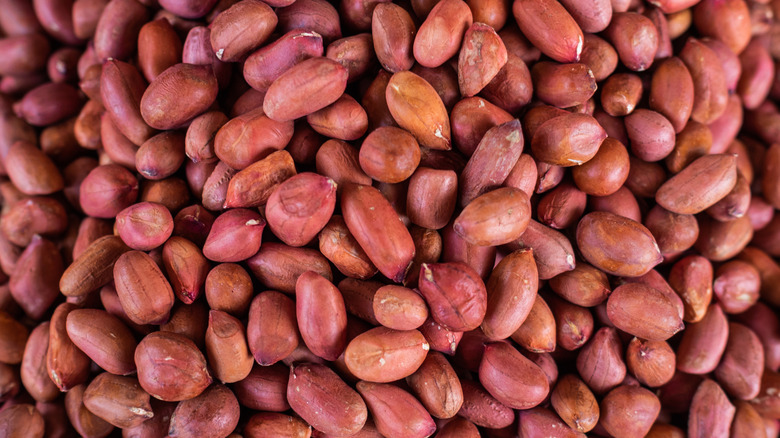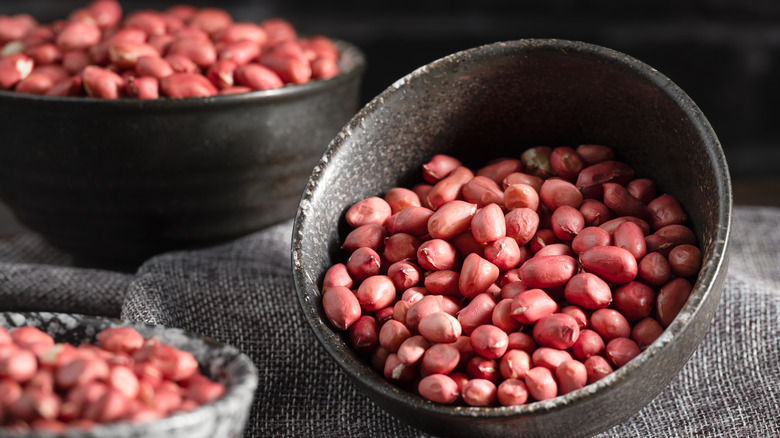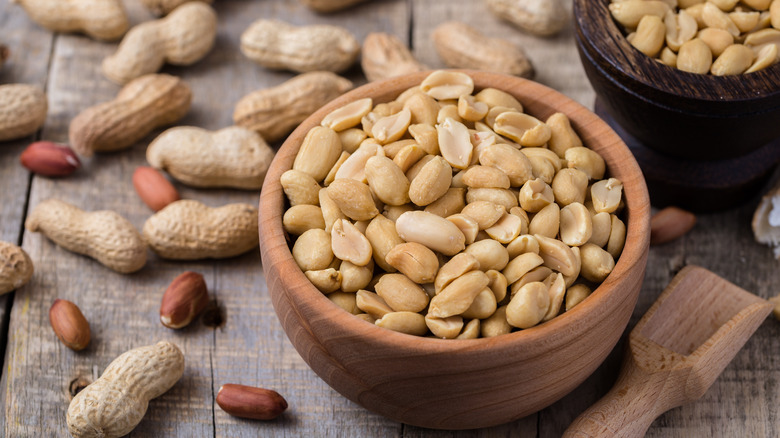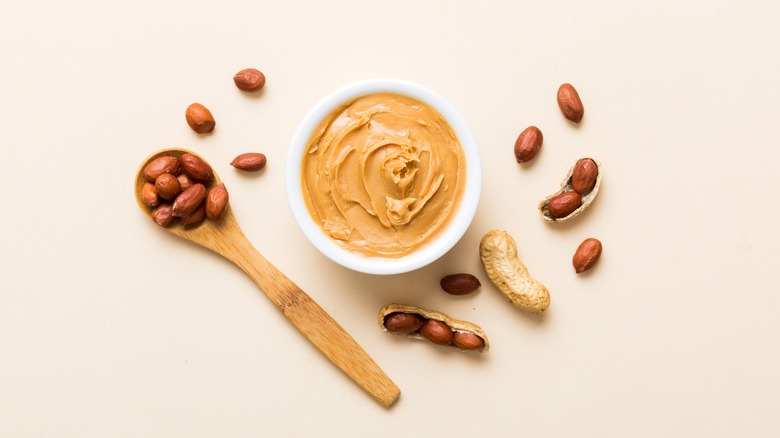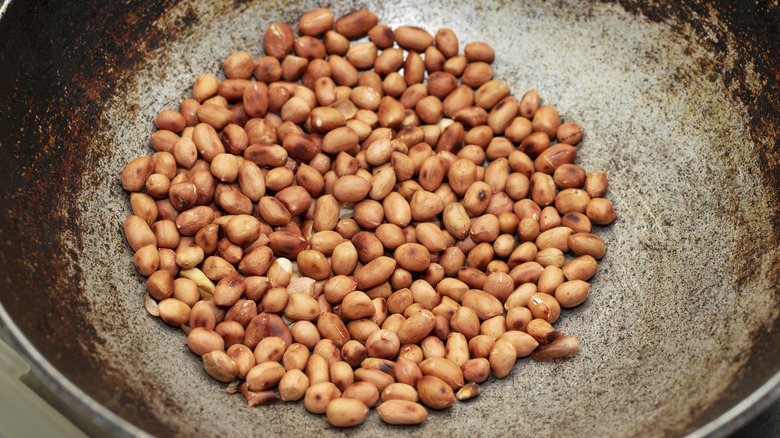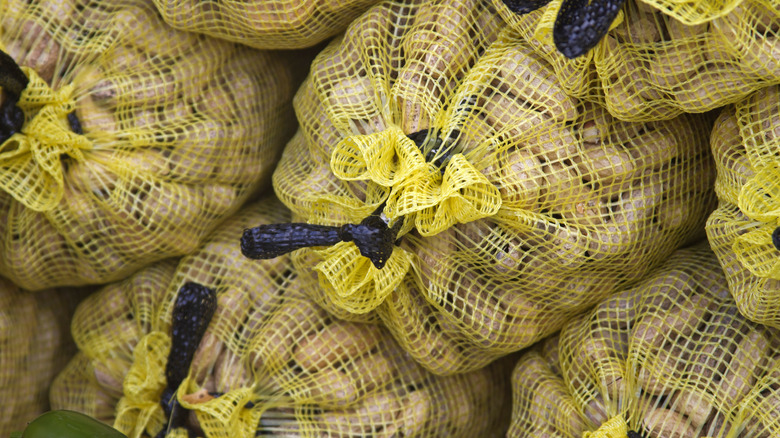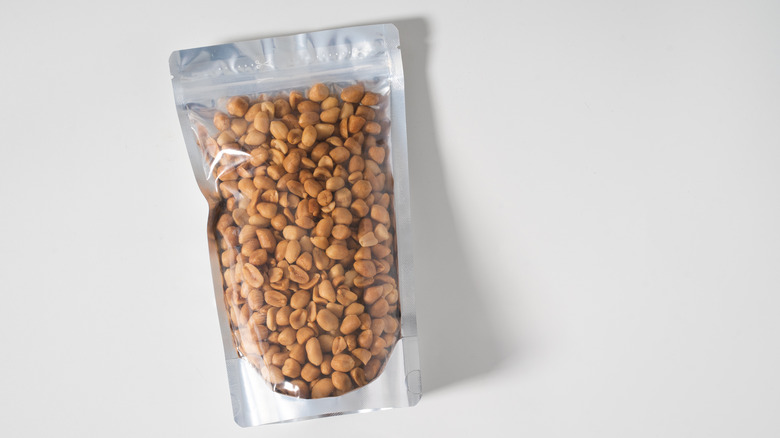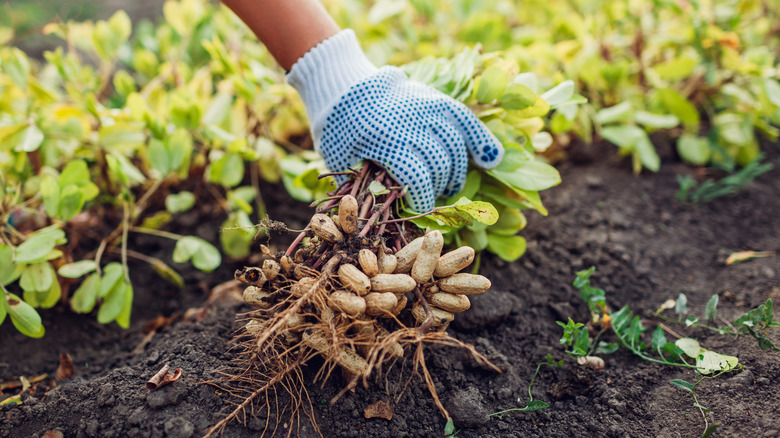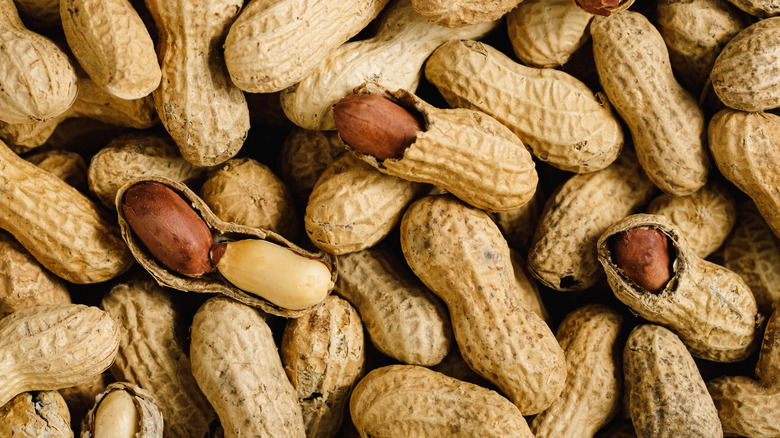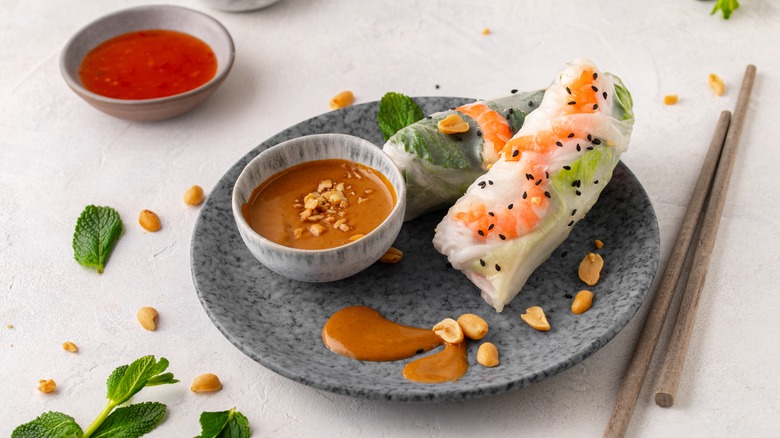What Are Spanish Peanuts And How Are They Used In The Kitchen?
We may receive a commission on purchases made from links.
When you think of peanuts, one of the first things that comes to mind is probably peanut butter, but what is now an American lunchroom staple is actually a relatively modern invention. The U.S. is only the fourth-leading producer of peanuts in the world, with China and India producing the most, where they're featured heavily in sauces, snacks, and sweets.
Peanuts are believed to have originated in South America, where they were carried back to Europe by Spanish explorers, eventually spreading around the world to Asia, Africa, and North America. Spanish peanuts are one of four main peanut varieties that made their way to the U.S. European settlers brought them to southeastern North America from Spain in the 1700s, and today, they flourish in the American Southwest. Spanish peanuts are as versatile as any other peanut, lending themselves to both savory and sweet applications, and everything in between. Let's learn more about this peanut variety and what sets it apart from the others.
What are Spanish peanuts?
The Spanish peanut (Arachis hypogaea) is one of four main varieties of peanuts grown in the U.S., accounting for about 2% of all peanuts produced. As with all peanuts, the Spanish peanut isn't actually a nut at all, but a legume related to chickpeas, soybeans, lentils, and other beans with edible pods and seeds. Spanish peanuts are loaded with protein, fiber, and heart-healthy unsaturated fats, just like its legume cousins.
More importantly, though, Spanish peanuts are delicious and have a wide range of culinary applications. Because they're sweeter than other peanuts, they're often featured in peanut candies like peanut brittle, but thanks to their bold nutty flavor, they also appear in many store-bought roasted nut mixes. In the U.S., Spanish peanuts are primarily grown in Texas, Oklahoma, and New Mexico. However, since Spanish peanuts are enjoyed around the world, they're also cultivated in South Africa, Spain, and Portugal.
Spanish peanuts vs. other peanuts
As we've mentioned, there are four different types of peanuts — Spanish, runner, Virginia, and Valencia — resulting from intentional selective breeding and natural selection in the wild. Each variation has unique characteristics and ideal culinary uses.
Runner peanuts, the most commonly produced and consumed peanuts in the U.S., are typically used in commercially-produced peanut butter. Due to their large size and attractive color, Virginia peanuts are the kind you'll find vendors selling at baseball games. Valencia peanuts, which have at least three kernels per pod, are the least-commonly produced peanuts in the U.S., and they're usually used when making boiled peanuts.
Compared to the other three types, Spanish peanuts are the smallest and are easily identifiable by their red skins. They have the highest oil content of all the peanuts, so they're often used commercially to produce peanut oil. In the kitchen, their sweetness and nutty flavor make them the perfect peanut for candy and confections, but they're also delicious when roasted in a savory seasoning mix.
What do Spanish peanuts taste like?
Imagine biting into a piece of gourmet peanut brittle that's absolutely packed with peanuts. The peanut flavor that comes to mind is probably that of a roasted Spanish peanut. Spanish peanuts exemplify the essence of peanut flavor — slightly sweet with a bold taste that is best described as nutty.
So, when you think about dishes where peanuts are the star of the show, you should think about Spanish peanuts. They have a mild nutty flavor and very little aroma when raw, but roasting them enhances their nuttiness. Spanish peanuts are sweeter than others, so they're usually used in candies and cookies. Their flavor shines in peanut-centered sweets like peanut brittle, peanut butter cookies, and sweet glazed peanuts.On the other hand, the robust nutty flavor that emerges when roasted lends Spanish peanuts to more savory applications like salted roasted nuts, peanut butter, and peanut-based sauces and soups, which are all improved by the intense peanut flavor of roasted Spanish peanuts.
How to cook with Spanish peanuts
Use Spanish peanuts in any recipe that calls for peanuts. Look to them whenever you want your dish to be bursting with nutty, slightly-sweet peanut flavor. You'll get the most intense taste from roasted Spanish peanuts, so you'll want to start there for most applications. You can buy pre-roasted, seasoned Spanish peanuts for a head start, but roasting them yourself will give you more control over your final dish's flavor.
Start with a pound of raw, shelled Spanish peanuts in a zip-top bag or food storage container. Add a tablespoon of a high smoke point oil — peanut oil is an obvious choice, but feel free to experiment with avocado, vegetable, or high-oleic safflower oil. Avoid butter and olive oil (especially extra virgin, as they can start smoking as low as 305 and 350 degrees Fahrenheit, respectively. Season with salt to taste. Remember, the more you salt your Spanish peanuts now, the less you'll want to add to the finished dish. Shake to coat, then spread them in a single layer on a baking sheet and roast them at 400 degrees Fahrenheit for about 10 minutes — less for mild nuttiness or more for a bolder flavor.
From there, the sky's the limit. Toss your hot roasted nuts with cinnamon and sugar for a sweet and savory snack, grind them into homemade peanut butter, stir them into peanut brittle or cookies, or add them to peanut sauce. Have fun with it!
Where to buy Spanish peanuts
Finding raw Spanish peanuts in stores can be easy or difficult, depending on where you're located. If you're in a major city with sizable natural grocery stores like Whole Foods and Sprouts, you can often find them in the bulk nuts section. Spanish peanuts are also available raw, shelled, and bagged in select Kroger (and Kroger-owned) stores under their Private Selection brand.
If you live outside the big cities, you may have a more challenging time finding raw Spanish peanuts in stores, but even so, you're not out of luck, as there are plenty of online retailers who sell raw Spanish peanuts, including Nuts.com, Mountain Man Nut & Fruit Co., The Peanut Trading Co., and even Amazon. But if you're in a pinch and need Spanish peanuts in a hurry, Planters sells them, salted and roasted, in the nut aisle of most major grocery stores.
How to store Spanish peanuts
Like most nuts, Spanish peanuts are loaded with natural oils that can go rancid over time, so proper storage is vital to keeping them fresh until you're ready to cook with them. Nuts with the shell still on are shelf-stable at room temperature for up to half a year, but shelled nuts can go bad much faster.
To keep the oils in your raw, shelled Spanish peanuts from going rancid, store them in a sealed freezer bag or food storage container in the fridge or freezer for up to six months. When it's time to use them, how can you tell whether the peanuts have gone bad? First, give them a sniff — putrid nuts will have an off-putting odor. If they pass the smell test, then taste a couple. If they taste bitter, they're past their prime, but if they're sweet and nutty, you're good to go.
Growing Spanish peanuts
If you've got a green thumb, or if it's difficult to find raw Spanish peanuts near you, you may wonder whether you can grow your own at home. The short answer is yes, you can, but it won't be quick, so you'll need a lot of patience — about six months' worth.
You can get Spanish peanut seeds from a garden store or order them online, but since peanut seeds are just raw peanuts, there are a few more creative ways to get your hands on them. Raw, unseasoned, shelled Spanish peanuts — like the ones you'd buy at the grocery store — will often germinate if planted, as long as the skins are intact. You can also find Spanish peanuts with the shells still on in some bird seeds, particularly those for parrots and other large domestic birds.
Since the peanut pods grow underground like potatoes, make sure you plant them in deep soil, whether that's in your garden or, if you're growing them indoors, in a potato grow bag. Find a spot where the plants will get full sun, then push the seeds an inch or two into the soil and wait for the magic to happen. In about four months, they'll be ready to harvest — pull them up, shake off the soil, and hang the whole plants upside down to dry for about two weeks. Then, remove the pods from the plant and let them dry for another two to four weeks before eating.
Nutritional information about Spanish peanuts
Spanish peanuts are jam-packed with nutrition in their little red kernels. Thanks to their high ratio of unsaturated fats to saturated fats, peanuts are a heart-healthy snack. Some studies show that consuming peanuts can reduce the risk of heart disease and even colorectal cancer (via Association of Food Scientists and Technologists).
They contain loads of essential nutrients like copper, niacin, manganese, phosphorus, thiamin, and Vitamin E. But Spanish (and other) peanuts' biggest nutritional claim to fame is that they have more protein per serving than other types of nuts and legumes. In fact, this plant-based protein is nutritionally equivalent to animal protein in eggs and meat.
Spanish peanuts are calorie-dense, with 832 calories in every cup of raw nuts, but studies have shown that eating peanuts may actually lead to weight loss and help with weight maintenance. The only downside is that roughly 2% of people in the U.S. are allergic to peanuts. If you're one of them, you should avoid Spanish peanuts, too. But even if you're not, if you plan to serve your peanut dishes to others, make sure they're informed as well.
Spanish peanut recipes to try
Ready to start using Spanish peanuts in your own kitchen and culinary endeavors? Roast a big batch in your oven with just a hint of salt, then chop some up and sprinkle them over a plate of piping hot homemade french fries to give them a nutty crunch. Next, you can throw the rest into a food processor and grind with a light drizzle of oil to make peanut butter at home. While you could just buy it at the store, that extra bit of effort is worth it when you use it in this super simple two-ingredient peanut butter fudge recipe.
If you're craving something a little more savory, you can add your roasted nuts and homemade peanut butter to this spicy coconut peanut soup with sweet potatoes and coconut cream. Want to whip up something a little quicker? This versatile satay-style peanut sauce takes just a couple of minutes to throw together, and it goes great with anything you want to add a punch of peanut flavor to — spring rolls, chicken, french fries, and more.
